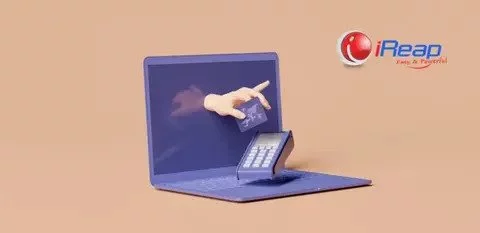
In a preceding discourse, you have become acquainted with the various iterations of Point of Sale, of which two categories are distinguished: the traditional variety and the cloud-based manifestation. The disparities between traditional Point of Sale (POS) and its cloud counterpart transcend the mere presence of internet connectivity; indeed, they encompass a multifaceted realm of distinctions. Thus, in this present exposition, you shall be illuminated upon the complete divergence between traditional POS and cloud-based POS.
The Essence of Traditional Point of Sale
The traditional Point of Sale (POS) encompasses a sales management system reliant upon tangible hardware, such as cash registers and other paraphernalia.
Therein, sales data and inventory remain subject to manual processing, whereby even the business proprietor is required to undertake physical stock counts, an endeavor consuming time in cross-verifying stock availability.
Cloud-Based Point of Sale
Cloud-based Point of Sale (POS) constitutes an analogous sales management system, albeit one endowed with a contemporary framework.
Embracing a cloud-based POS regime affords the ability to manage business data online, spanning transactions, inventory, payment receipts, and inventory holdings.
All such data perpetually presents in real-time and stands accessible from any location and at any juncture of your need...
Differentiating Traditional Point of Sale and Cloud-Based POS
Having apprehended the foregoing elucidations, you now possess a semblance of the contrast between these two modes. Yet, for enhanced clarity, the ensuing discourse delves into the nuanced disparities that set traditional Point of Sale apart from its cloud-based counterpart.

1. Infrastructure and Data
The utilization of a traditional POS warrants a medley of hardware and software components. Hardware requisites encompass cashier computers, data storage hard drives, receipt printers, and localized servers.
Moreover, necessitating software components encompass cashier software, accounting software, inventory management software, and the like.
Contrastingly, the cloud-based Point of Sale obviates much of the physical infrastructure and its associated costs. Remarkably, a smartphone or tablet suffices for its operation.
Furthermore, data within the cloud-based POS is safeguarded within cloud repositories, enabling facile data access without necessitating a physical visit to the business premises.
2. Costs
By virtue of demanding elaborate hardware infrastructure, the employment of traditional Point of Sale engenders heightened financial outlays. Additionally, licensing fees for cashier software or software modules are requisites. Further, the installation process of the traditional POS is reliant upon specialized technicians, incurring supplemental charges.
In contradistinction, cloud-based Point of Sale tends toward economical feasibility, for it predominantly relies upon smartphones. Subscription expenses for cashier applications are far more accessible, given their conformance with the Electronic Point of Sale (EPOS) paradigm. Annual application subscription payments, commonly, are substantially more economical compared to monthly installments.
3. Updates and Integration
Pertaining to the traditional Point of Sale, software updates may engender temporal demands and augmented exertions, sometimes entailing supplementary costs.
Moreover, when incorporating supplementary devices or systems, such as linking cashier software with accounting software, integration complexities are markedly heightened vis-à-vis cloud-based POS utilization.
Inclining towards efficiency and efficacy, the cloud-based Point of Sale autonomously updates software versions. Augmenting system components, such as the integration of inventory management and analytical tools to monitor business performance, is executed with heightened seamlessness.
4. Accessibility and Mobility
The cloud-based Point of Sale seamlessly facilitates remote access to business data through internet connectivity, a feature advantageous for multi-location businesses or proprietors engaged in frequent travels.
Conversely, the utilization of traditional systems necessitates on-site presence for data retrieval. This is due to the local server storage or even the retention of data within the cash register computer’s hard drive.
5. Data Security
The security of data is a paramount concern in any enterprise. Within the purview of traditional Point of Sale, the risk of data loss or hardware impairment may result in data forfeiture. Moreover, data confined to a single device lacks the ability to facilitate automated backups.
Contrarily, cloud-based Point of Sale generally integrates added security measures, including data encryption and automatic backups. Furthermore, the option to schedule periodic data backups exists, serving to shield business information and minimize the prospect of data loss.
Illustrative Instances of Traditional and Cloud-Based Point of Sale Implementation

1. Illustrative Instance of Traditional POS Implementation
Suppose you possess a business reliant upon a traditional Point of Sale system. Upon every transaction, the cashier is obliged to manually input data into the system.
Data input encompasses details such as the name and price of purchased items or products. A miskeyed entry could thereby lead to data inaccuracy in sales records.
Furthermore, post-sale, the cashier must perform inventory calculations, deducting quantities of sold products. This endeavor is often accompanied by the compilation of daily and monthly sales reports, a time-intensive undertaking. Amendments to menus or price adjustments may similarly demand supplementary temporal allotments.
Though it bears inherent limitations and fails to engender automation, the traditional Point of Sale yet finds utility within modestly scaled businesses, particularly those with limited product diversity.
2. Illustrative Instance of Cloud-Based POS Implementation
Now, envisage a business realm wherein you preside over a clothing store, replete with varied categories, brands, colors, and even models.
In this scenario, easy accessibility to stock availability through smartphone or tablet interfaces is a tangible boon. This facility is expedited by your adoption of a cloud-based Point of Sale system.
Upon attaining such knowledge, you promptly furnish desired products to patrons, receive payments, and every sales transaction is contemporaneously recorded within the system in real time.
A further advantage of Point of Sale emerges: the rapid adjustment of inventory quantities, the application of discounts, and the orchestration of customer loyalty programs. All data remains securely ensconced within the cloud, facilitating expeditious retrieval at later intervals.
It warrants mention that in the realm of fostering customer loyalty, iReap POS extends the provision of a loyalty program feature. For an in-depth exposition, kindly refer to the discourse entitled “Utilizing the Loyalty Program Feature in iReap POS.”
Thus, you have now come to a comprehensive understanding of the divergence between traditional Point of Sale and cloud-based POS systems. Proceed to align your choice with your business requisites and the feasibility of implementation.
However, should your inquiry extend to discerning the merits of employing an internet-connected (online) cashier application versus an autonomous (offline) operation, prudent investigation within the discourse titled “Online vs. Offline Cashier Applications: Optimal Suitability” is advised.



